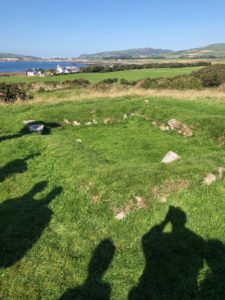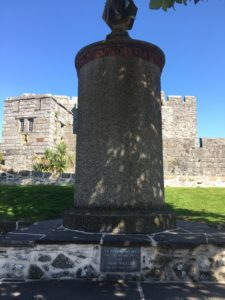
We imposed few expectations on the Isle of Man.
This was based more on ignorance than fact or opinion.
We all later agreed Mann was one of our two favorite destinations.
Mann was home to the Celts, then early Christians, then Vikings, and now the very wealthy and the annual Isle of Man TT motorcycle race.
Our day consisted of a five-hour excursion to Castletown, which included a visit to an early Christian and thereafter a Viking settlement and burial ground, and a three mile walk along the coast back to Castletown.
We then spent the afternoon in Douglas, the island’s largest town, shopping and eating before a visit to the museum and a stroll—or was it a saunter—along the boardwalk back to the ship.
As Bede draws his Ecclesiastical History of the English People to a close in 731 A.D., he notes that the Gospel had tamed the Picts and the Irish and peace and prosperity prevailed throughout the kingdom:
As such peace and prosperity prevail in these days, many of the Northumbrians, both noble and simple, together with their children, have laid aside their weapons, preferring to receive the tonsure and take monastic vows rather than study the arts of war. What the results of this will be the future will show.
Sixty-two years later the pagan Vikings arrived in their longboats on the island of Lindisfarne and for the better part of two hundred years repeatedly attacked, pillaged, and then ruled Britain, parts of Ireland, and the surrounding islands, including the Isle of Man.
A few miles outside of Castletown near the bay at Port St. Mary’s, we visited Keeill Vael, where a Christian chapel once stood. The stone foundation is still there. The area surrounding was also used as a Christian cemetery. But on top of the Christian cemetery were found Viking artifacts, including a Viking buried in his longboat, along with his horse and food. He was also buried with a female who was apparently his wife, part of whose skull was chopped off when she was killed and put into the grave with him. Such pagan practices persisted for the better part of 200 years, until the Gospel would again prevail.

What did the Christians of Bede’s time who had enjoyed the peace and prosperity that accompanies the proliferation and reign of Christianity think when the Vikings arrived? Did they think it was the end of the world? Probably. Did they consider that by not sending missionaries to the Vikings in Scandinavia that perhaps God had allowed the Vikings to come to them? If they understood the importance of the kingdom of God over earthly kingdoms, this explanation might have seemed quite plausible.
When we arrived back in Castletown after our walk along the coast we had some free time to look around the town. I went to Castle Rushen, looked around, and took some pics. After we returned to the bus Ann and Cindi mentioned something how interesting it was to see where John Wesley had preached. I said, “What?”
As it turned out, I had been standing right next to the monument commemorating Wesley’s preach here on May 31, 1777 and never saw the plaque. Worse, Ann and Cindi never mentioned it while we were wondering around the square. I gently reminded them of their duties as part of the GSB team and secured an oath they would never fail to inform me of such a find in the future. Fortunately, Cindi took a pic and airdropped it to me, and I have included it here.
Until tomorrow. GS
